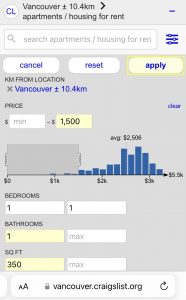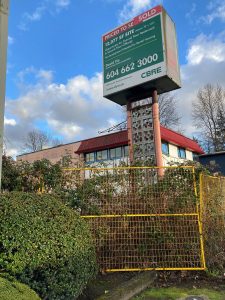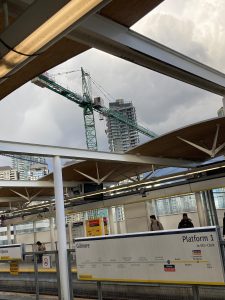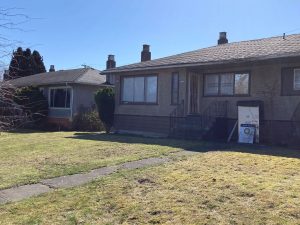
Emilia Davies
Emilia Davies is a spring 2023 graduate from the Interdisciplinary Studies program at Capilano University. She has been recognized on the dean’s list for consistently high grades for multiple semesters. Her experience has involved the outdoors in various capacities including work with animals, multi day trips and cross country ski coaching. She would like to continue incorporating these interests into her future life and work opportunities.
Personal Narrative
An Initial Note. I understand not everyone is fascinated by housing policy, but the simple fact is that everyone sleeps and we all need somewhere to do that. This is a long paper with a lot of information, so if nothing else, consider this. Housing for low income individuals should not be a good will gesture. Vancouver’s current rental system allows more affluent people and for profit developers to take advantage of those in need of housing. Though managing a property takes a lot of time and money, it should not be the responsibility of one citizen to house another. This is what the government is for.
The issue of housing is a constant in Vancouver dialogue. Those who secured a place in this city were those in previous generations with the means to buy property before the prices became debilitating. It truly feels like some won the lottery by deciding to buy while others did not. This issue is relevant all across Canada, but my experience reflects Vancouver which happens to be famous for its ever climbing housing prices and, consequently, housing crisis.

I have always been aware of affordable housing, but never actually explored the definition. Having recently moved out of my family home and spent hours browsing rental listings in what has historically been one of Vancouvermost affordable neighbourhoods, I became interested in what constitutes affordable housing and who benefits from it. This combined with the constant narrative of Vancouver’s ever worsening situation has drawn me to look at why this is still the case when I am continually hearing about the development of affordable units. If this is truly happening where are the results? Virginia Holden from Victoria Housing Society highlights this issue with the discouraging statistic that BC is in fact losing more units than it is gaining (Goldvine). With 100,000 people moving to BC in 2021, setting a 50-year record (“Khalon Mandate”, 3), this decline in housing availability is troubling but understandable.
Aside from the somewhat abstract politicized arena, it feels like we are all individually engaging with this issue in our own bubbles. This separation between the social and the political highlights a problem with how we collectively perceive and approach housing. Jill Atkey, CEO of BC Non-Profit Housing Association (BCNPHA), describes the concept of interconnectedness as a “housing ecosystem” on the podcast “Let’s Talk Housing” (season 1 episode 1). Recognizing everybody’s impact on the trajectory of Vancouver’s housing market could be a powerful way to influence attitudes on affordable housing.
Setting the Scene
Imagine, for a moment, you wake up on the first of the month and rent is due. You have some extra unforeseen expenses and groceries prices are higher than ever. It is going to be an expensive month. Relief washes over you as you remember you just moved into one of Vancouver’s many highly regulated non-market rental developments where only a maximum of 25% of your income goes towards housing costs every month. You make sure to transfer over the $650 for rent before you step out of your 500 square foot one bedroom apartment onto Commercial Drive to do some grocery shopping.
This scenario may seem like an impossible dream, but with a lot of work and significant change in the types of housing the city, province and country prioritize, it could be an attainable reality. Rent does not have to be a debilitating $2,000 (on average) expense every single month.

Introduction
There are so many actors in Vancouver’s housing market, each with individual systems for contributing to the city’s housing needs. Anybody who has scoured rental listings or seen the numbers of unhoused Vancouver residents can see there is a serious problem. An increasing portion of the population is unable to afford housing, putting strain on structures like community housing meant to help those whose needs aren’t met by market prices. There is now a much larger percentage of the population in this category than previous years (Goldvine). Because there are so many people struggling, those with the least money and resources are pushed out of the housing market completely. Both renters and owners are affected as “housing costs grow faster than local incomes” (Yan). Housing is always a source of debate on municipal, provincial and federal levels. While grants, subsidies and initiatives are in place, the election driven policy based discourse feels disconnected from the daily realities of navigating unattainable housing prices. Graham Plant, a Principal at CPA Development Consultants, emphasizes the need to “invest heavily in supportive housing” as well as in the “incentives and funding required to build non-market housing”. For context, non-market housing according to “Metro Vancouver Housing”, is affordable housing that is owned or subsidized by government, non‐profits, or housing cooperatives, and where the housing is provided at below market rents” (135). Putting pressure on private for-profit development with more affordable unit prices will force a decrease in cost to maintain competitive prices.
Barriers to Housing Affordability
A Brief Historical Context. While other cities have a history of non-market housing, Vancouver is extremely behind in this area, at 5%, because of a period of minimal federal funding of non-market housing between 1995 and 2016 (“The Non-capitalist Solution”). Additionally, Atkey points to the city’s historical lack of purpose built rental units as well as a hiatus on new housing supply spanning a couple generations (Goldvine, “Let’s Talk Housing”). These actions have had a lasting impact on Vancouver’s housing market, resulting in a “backlog of 80,000 low and moderate rental units” (Goldvine).

Policy and Pricing. Apartment rental prices and sales in metro Vancouver have increased 92% and 186% respectively between 2005 and 2021 while weekly wages have only risen 60% in this time (“Metro Vancouver Housing”, 74,113). Incomes are not increasing enough to keep up with housing prices and the types of units people can afford reflect this. The average price of a one bedroom in a 10.4km radius of Vancouver on Craigslist is currently $2,506/month (Craigslist Vancouver). For this price to be deemed affordable as per the 30% rule, Vancouverites need to be making on average $8,350 per month which is simply not happening.
A variety of social and political factors have contributed to the position Vancouver is now in. The current Ministry of Housing Service Plan directly points to Vancouver’s main barriers to affordable housing, specifically identifying “market speculation” and the commodification of housing as a means for profit rather than a “core need” (7). Greenberg adds that not only does Vancouver need more units, but the types of developments need to be better tailored to vulnerable populations. Many so-called solutions still enable private for-profit actors to continue gaining exorbitant wealth from low middle income residents.
Frances Bula outlines the Rental Construction Financing Initiative’s assessment and criteria of affordable projects providing proof that although there is a federally recognized understanding of affordable housing, there is no overarching criteria for all sectors of the housing market. For example, the RCFI considers a project affordable if “at least 20 per cent of its residential units rent for less than 30 per cent of the median income of families in the surrounding area” (Bula). This type of criteria creates a setting where gentrification can run rampant and eventually force out local residents. If affluent families and individuals move into a low income neighbourhood, their mere presence inflates housing costs. While it is generously funded and touted as a solution, the RCFI still excludes those most in need because of its “affordable” housing parameters. Although it has led to some below market rentals, Bula observes that “in many cases the rental costs are still higher than local averages”. While housing of all kinds is useful and needed, more options must be made available to those who are excluded from higher price brackets. According to Plant, creating more availability is slow moving as the process takes “from 4 to 7 years from start to finish” due to many factors including lengthy zoning approval.

Social and Systemic Barriers. The inability of buyers and renters to keep up with the housing market goes far beyond housing prices as an individual phenomenon. Rather, it is made up of a culmination of social and systemic failings. One major factor in this breakdown, Greenberg points out, are Vancouver’s relatively low average wages compared to high market housing prices. It is useful to look at these numbers next to other cities and different living expenses to better understand the Vancouver context. For example, “[h]ome sale prices have doubled and tripled over the past 15 years, much faster than wages or inflation” (“Metro Vancouver Housing”, 74). To put this in perspective, BC’s median income is $67,500 putting it in fourth place below Alberta, Ontario and Saskatchewan and marginally above Canada’s average of $66,800 (“Cost of Living in Canada”). Vancouver’s average yearly income, according to the site Point2 Homes, is $72,000 after tax while Saskatoon’s is $74,000 (this number varies slightly depending on the site). Simply put, Vancouver and Saskatoon have comparable average yearly income, but Vancouver’s rental prices are twice that of Saskatoon meaning the same amount of money will go half as far when budgeting for rent in Vancouver (“Cost of Living Canada”). Another useful way to highlight disproportionate rental prices is breaking down living expenses. For a single person, average housing costs take up more than half of monthly expenses indicating that this is truly the issue that needs to be addressed (“Cost of Living Canada”). It is therefore no surprise that 35% of renter households put more than 30% of their income into housing, excluding them from the “affordable” category (“Vancouver Plan”, 9).
Solutions
Policy Driven Solutions. Each change in government brings a promise and implementation of new solutions. As of the 2019 passing of the National Housing Strategy Act, housing is finally recognized as a human right (“To Buy or to Rent”). Although Vancouver’s housing history has not lent itself to an affordable or rent friendly market, governments continually implement new policies and initiatives to combat the ever worsening crisis. On a federal level, developments receive funding through programs like the Rental Construction Financing Initiative (“Progress on the National Housing Strategy”), while new measures have recently come into effect provincially. A Ministry for housing was just implemented in December 2022 as well as a Rental Protection Fund. Pre-zoning and Community Amenity Contributions (CACs) are examples of policies implemented within municipalities.
Receiving $25.75 billion over an eleven year period, the Rental Construction Financing Initiative has the resources to reach a broad scope of developments (“Progress on the National Housing Strategy”, 2). The affordability parameters do not, however, recognize the requirements of those in need, and depend instead on the situations of other citizens to dictate “affordability”. The Canada Mortgage and Housing Corporation (CMHC) eligibility parameters for this initiative mandate that “[a]t least 20% of units must have rents below 30% of the median total income of all families for the area” and that they “should be maintained for at least 10 years”. This particular solution, while providing some relief, seems like only a partial commitment with convenient exit strategies along the way.
A recent and more pointed addition to the housing crisis toolkit has been the formation of the Ministry of Housing in December 2022 along with Ravi Kahlon as Minister of Housing. The 2023-2026 Service Plan lays out its directive to “focus on the creation of increased housing supply that is attainable and affordable for people in British Columbia” (5). As the Minister of Housing, Khalon is expected to focus on high need municipalities by implementing the Housing Supply Act and set targets to “fast-track construction and redevelopment of affordable homes” (“Kahlon Mandate”, 4). The province is wasting no time, already launching the Rental Protection Fund, a new endeavour addressing existing rentals to ensure rent stays relatively affordable and tenants are not evicted upon development (“New Rental Protection Fund”). The fund’s goal is to enable non-profit housing organizations to acquire currently affordable residential properties at risk of being repriced or redeveloped into more expensive units, with conditions that existing tenants not be displaced (“New Rental Protection Fund”). With more province wide measures such as these, local programs can be implemented more efficiently.
Pre-zoning is one example which can, once implemented, significantly speed up development to meet Vancouver’s housing needs (Lee, 6). Like any others, non-market developments endure a rigorous approval process before financing is finalized and would benefit hugely from this step. In addition to pre-zoning, operating on a break-even basis would mean only needing to cover upfront cost of development with rental prices (Lee, 4). To further reduce prices for those who need it, Lee suggests cross-subsidy arrangements where those who can, cover a portion of the price to lower cost for others (2). With this system, once development costs have been paid off and it has paid for itself, rental prices can actually be decreased (“The Non-Capitalist Solution”).
A strategy since 1989, Community Amenity Contributions (CACs) are a helpful tool, but not specifically dedicated to affordable housing (Hyde, 2, 6). As a high priority issue, affordability strategies have increasingly been a focus of CACs. Brady Faught, a member and co-founder of his co-housing living arrangement, has experience with the process of implementing CACs. He recalls pushback from the municipality when suggesting CACs go towards subsidizing some units to below market pricing, as other amenities were also high priority for funding.
Applying Social Change. While governments, non-profits and private developers are always finding innovative new solutions, the most important one, according to Hemingway, is flooding the market with non-market housing. Existing (and often valuable) efforts will then be better suited to complement this new system. Logistical solutions within this framework will more effectively shape new and exciting approaches to sustainably affordable housing. Modular housing is an example of this, cutting up to 20% of building costs as well as time (Lee, 6). This is significant as material cost inflates prices even when operating on a break-even basis and eliminating profit margins. Once systems are in place to fast track the bureaucracies of development, as pre-zoning is more widely approved, economies of scale principles can produce more homes for even lower cost (Lee, 6). These solutions are complex and multifaceted, but Vancouver’s affordable housing experts are incredibly experienced and well equipped to tackle the challenge of affordability. Implementing a primarily non-market housing model will finally allow them to meet their full potential and truly solidify housing as a human right.
Cities as Examples for Vancouver. While Vancouver may be touted as one of the most liveable cities in the world and continues to make housing affordability a top priority, there are many other cities from which it can take inspiration. Vienna, Austria is one example. Its commitment to making housing a human right is evidenced by the fact that 60% of residents live in non-market housing compared to Vancuver’s 4.2% (“Non-Capitalist Solution”, “Metro Vancouver Housing”, 134). Looking at cities with a high ratio of non-market to market housing shows how important this step is in lowering housing costs. In comparison to Canada’s widely used 30% of household income, government regulation in Vienna ensures that this number stays at or below 25% (“Vienna’s Unique Housing Strategy”). Simply having this piece of regulation provides a more clear and attainable base-line for both developers and consumers. Another component of Vienna’s success is the lack of stigma surrounding the term “social housing” (Hernández-Morales). Making these buildings attractive desirable places to live eliminates the divide between lower and higher income housing complexes. This system also ensures that even if residents’ incomes increase, their rent does not increase, meaning that middle income families often stay in social housing units creating diversity within the buildings (Hernández-Morales). Unlike Vancouver where this would be seen as a misuse of resources, the wide availability of Vienna’s non-market units allows for mixing of income brackets. Social housing sets prices that relieve the burden of financial over extension. Vancouver and Vienna are in different places and Vancouver has to tweak its policies in order to best cover the needs of the most vulnerable. While in Vienna “[t]he only requirements for accessing social housing are meeting a cap on income . . . so high that 75 percent of the population qualifies” (Hernández-Morales), Vancouver would need to ensure that those who truly need it have access first.
Greenberg suggests Singapore as another model from which to take inspiration. Although it functions in a very different way politically than Vancouver, aspects of its housing policy are worth emulating. A capitalist society by nature, Singapore endorses free market trading but not when it comes to housing, Greenberg emphasizes. Housing is in a class of its own, outside capitalist driven commodification. Like Vienna, a majority of Singapore residents, 78.7% to be exact, live in non-market housing, or in this case Housing and Development Board(HDB) flats (“Population Trends 2021”, 19).

Conclusion
There are so many solutions being put forward federally, provincially and on municipal levels. While providing a certain level of relief, the Rental Construction Financing Initiative has its own complications. It is a solution in our current commodity driven system, but not the systemic switch Vancouver is so desperate for. Flooding development with non-market units is a proven solution, but undermines the for-profit actors who hold a lot of economic power in housing development. As one of the most expensive cities in the world, Vancouver is in a uniquely challenging position. Local solutions like the co-housing system brought forward by Brady Faught, will help change the way we approach housing in this city. Adapting the ways we engage with and use living spaces can also reduce expenses in other areas. Faught describes how a more cooperative method of living promotes sharing cars, food and communal spaces as well as exchanging child care services. All of this together decreases living costs. Solutions to the housing crisis must be innovative and bold in order to make perceptible change. Contributions, offerings and donations “gifted” to affordability initiatives by developers are band aids to a systemic problem and simply not enough (Hyde, 8). Vancouver itself is already set up in a comprehensive and liveable way, it is now time for the government to take action in making it a place for newcomers and longtime residents to build their lives.

Works Cited
Bula, Frances. “Despite Election Promises, Federal Parties Do Not Control Many Factors Affecting Availability, Cost of Homes.” The Globe and Mail, The Globe and Mail, 13 Sept. 2021, https://www.theglobeandmail.com/canada/british-columbia/article-despite-election-promises-federal-parties-do-not-control-many-factors/.
“To Buy or to Rent: The Housing Market Continues to Be Reshaped by Several Factors as Canadians Search for an Affordable Place to Call Home.” Statistics Canada, 21 Nov. 2022, https://www150.statcan.gc.ca/n1/daily-quotidien/220921/dq220921b-eng.htm?indid=32991-2&indgeo=0.
Craigslist Vancouver. “Apartments / Housing for Rent near Vancouver, BC.” 5 Apr. 2023, https://vancouver.craigslist.org/search/vancouver-bc/apa?lat=49.2491&lon=-123.0798&max_bedrooms=1&max_price=1500&min_bedrooms=1&search_distance=6.7#search=1~gallery~0~0.
“Point2 Homes.” Demographics in Vancouver, BC, 2021, https://www.point2homes.com/CA/Demographics/BC/Vancouver-Demographics.html#:~:text=The%20median%20household%20income%20in%20Vancouver%20is%20%2482%2C000%2C%20while%20the,sits%20at%20%2472%2C000%20per%20year.
Faught, Brady. Interview. Conducted by Emilia Davies. 28, Mar. 2023.
Goldvine, Sara. “Creating Affordable Housing.” and Let’s Talk Housing: A Podcast by BC Housing, BC Housing, Season 1 Episode 1, 25, Jan. 2022, https://www.bchousing.org/podcast
Greenberg, Charles. Interview. Conducted by Emilia Davies. 28, Mar. 2023.
Hemingway, Alex. “Financing Public Housing: How a Massive Expansion of Rental Homes Can Literally Pay for Itself.” Policy Note, 26 Apr. 2022, https://www.policynote.ca/financing-public-housing/.
Hernández-Morales, Aitor. “How Vienna Took the Stigma out of Social Housing.” POLITICO, POLITICO, 3 Mar. 2023, https://www.politico.eu/article/vienna-social-housing-architecture-austria-stigma/.
Hyde, Zachary. “Gift Giving in the Neoliberal City: Polanyi’s Substantivism and the Exchange of Density for Affordable Housing in Vancouver.” Environment and Planning A: Economy and Space, 2021, https://doi.org/10.1177/0308518×211022746.
Lee, Marc. “How to Build Affordable Rental Housing in Vancouver.” Canadian Centre for Policy Alternatives, 2021
“Metro Vancouver Housing Data Book.” Metro Vancouver, Dec. 2022, http://www.metrovancouver.org/services/regional-planning/data-statistics/housing-data-book/Pages/default.aspx.
“Ministry of Housing.” 2023/24-2025/26 Service Plan. British Columbia, Feb. 2023.
“New Rental Protection Fund Will Address Growing Loss of Affordable Housing.” BC Non-Profit Housing Association, 19 Jan. 2023, https://bcnpha.ca/new-rental-protection-fund-will-address-growing-loss-of-affordable-housing/.
“The Non-capitalist Solution to the Housing Crisis.” Youtube, uploaded by About Here, 1 Nov. 2022, www.youtube.com/watch?v=sKudSeqHSJk.
Plant, Graham. Interview. Conducted by Emilia Davies via email correspondence. 01 Apr. 2023.
“Population Trends 2021.” Department of Statistics Singapore, Republic of Singapore, 2021
“Progress on the National Housing Strategy.” A Place to Call Home, Government of Canada, 31 Dec. 2022, https://www.placetocallhome.ca/progress-on-the-national-housing-strategy.
“Vienna’s Unique Social Housing Program: HUD USER.” Vienna’s Unique Social Housing Program | HUD USER, https://www.huduser.gov/portal/pdredge/pdr_edge_featd_article_011314.html.
Yan, Andy. “Making Room for Whom?” Vancouver Sun, 4 Feb. 2022, https://vancouversun.com/opinion/andy-yan-making-room-for-whom.
